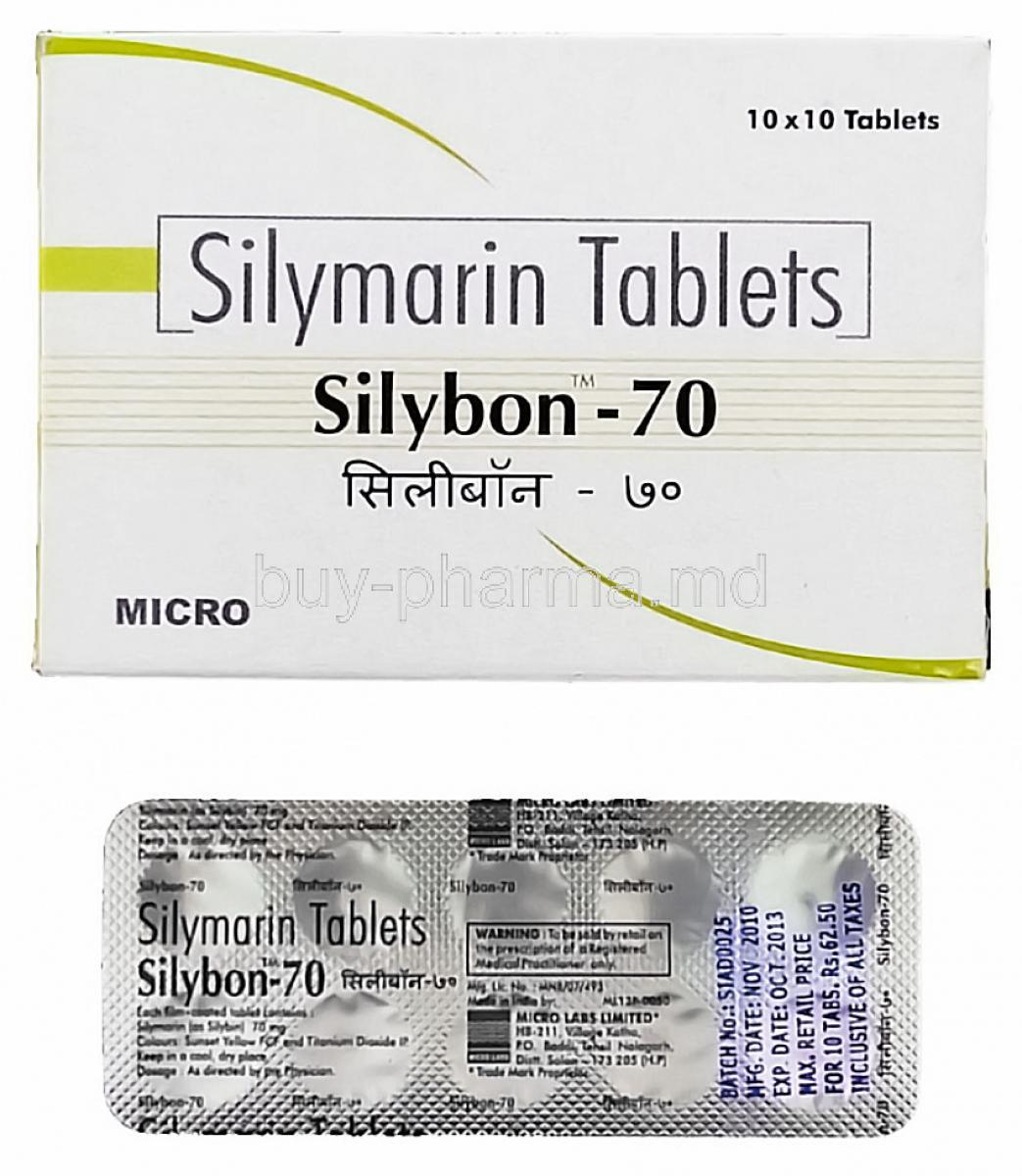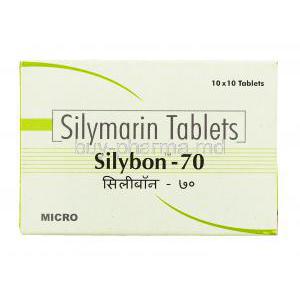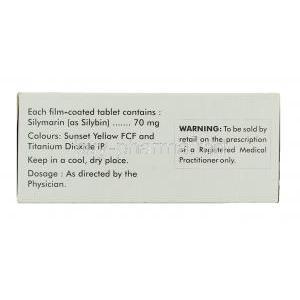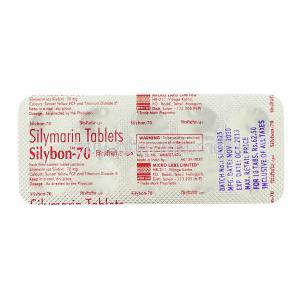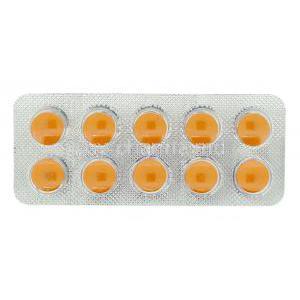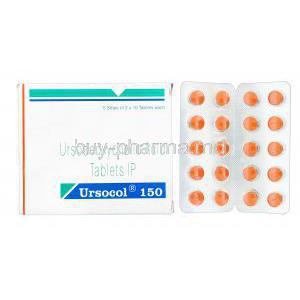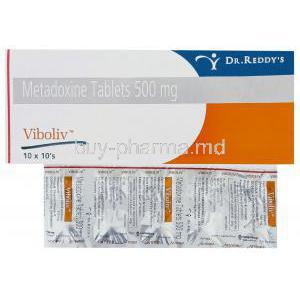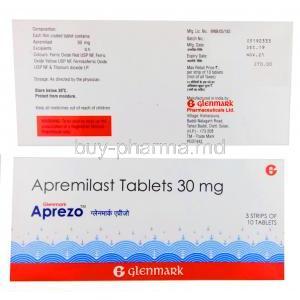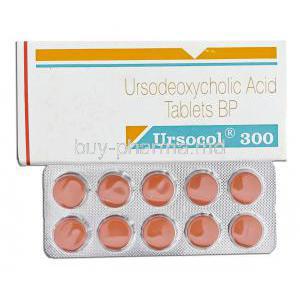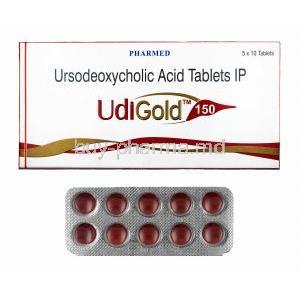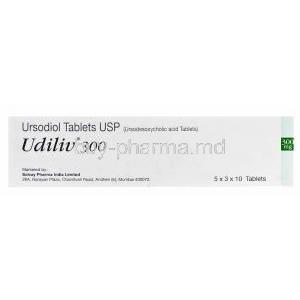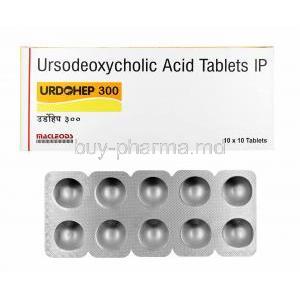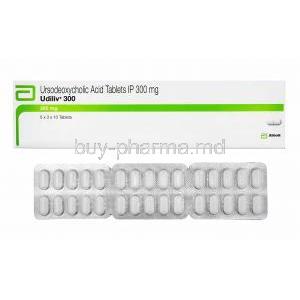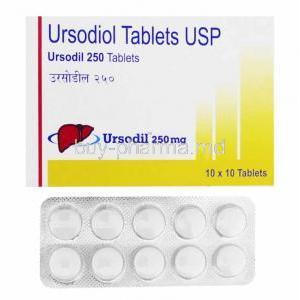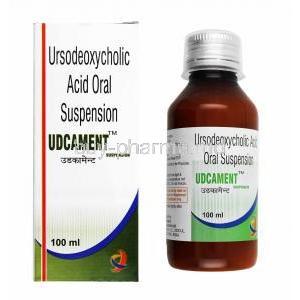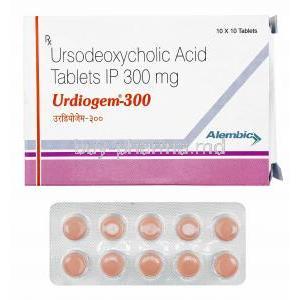Silybon, Silymarin

Silybon, Silymarin
Introduction
Exploring the realm of Silybon and Silymarin takes us on an adventure where science and history intertwine, providing insights into the origins and characteristics of these compounds.
Brief overview of Silybon and Silymarin
Silybon, a variation of the Silymarin, is well-regarded in the field of liver health. Extracted from milk thistle (Silybum marianum), Silymarin has been highly esteemed for its healing properties throughout history.
Historical context and development
The historical significance of Silymarin runs deep, as it has been recognized in medicine since ancient times. Through scientific research, we have better understood its composition and various uses over the years.
Composition
Understanding the complexities of Silybon requires delving into its makeup, which consists of a skillfully blended combination of essential components designed for optimal therapeutic effectiveness.
Detailed composition of Silybon
Silybon is a pharmaceutical product that contains a combination of bioactive compounds. It consists of flavonolignans, specifically silybin, silydianin, and silychristin each playing a role in its therapeutic effectiveness.
Key ingredients
- Silybin is a flavonolignan that is well known for its ability to protect the liver.
- Silydianin contributes to the properties of Silybon, helping to strengthen cellular resilience.
- Silychristin enhances the effectiveness of Silybon by complementing the actions of its counterparts.
Formulations and variants
Silybon's versatility is demonstrated by the range of formulations and options available that cater to individual health requirements. Whether in the form of capsules or liquid extracts, these different choices guarantee a customized approach to supporting liver health.
How it Works
Understanding how Silymarin works provides insights into its effects on liver health, creating a story of safeguarding, antioxidant properties, and detoxification.
Mechanism of action of Silymarin
Silymarin plays a role in its therapeutic effects by influencing different cellular pathways. When it interacts with cell membranes and proteins inside cells, it sets off a series of events that strengthen the integrity of the cells.
Liver protective properties
Silymarin showcases its ability to protect the liver by safeguarding liver cells against stress, reducing inflammation, and supporting the restoration of damaged tissues. It acts as a defender of liver health, standing strong in the face of toxins.
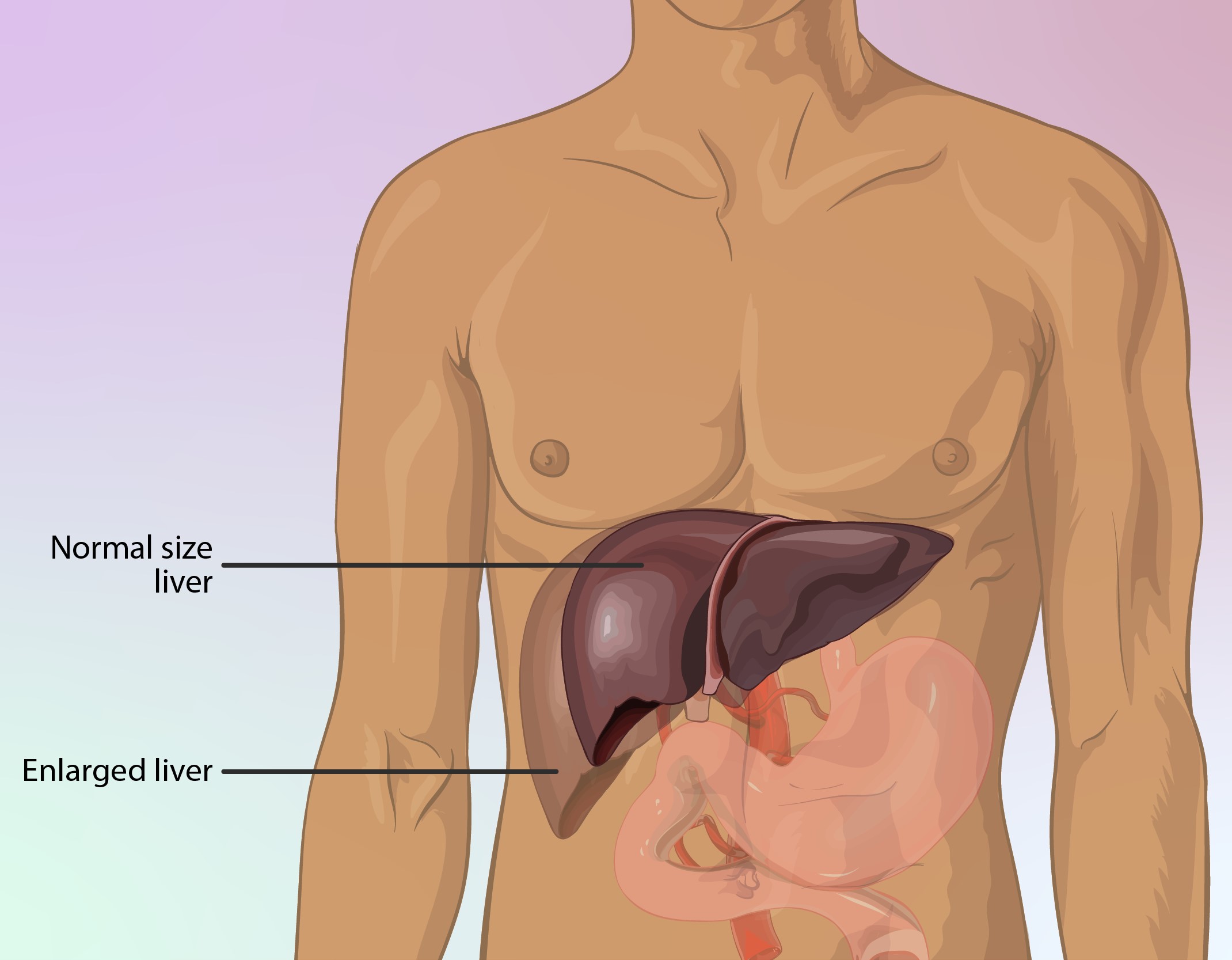
Enlarged/Inflammed Liver
Antioxidant effects
At this level, Silymarin is a powerful antioxidant that combats free radicals and reduces oxidative damage. Its capacity to counteract oxygen species plays a crucial role in maintaining cellular balance and promoting longevity.
Impact on detoxification pathways
Silymarin has an impact on the liver's ability to get rid of harmful substances by enhancing detoxification pathways. It helps maintain a detoxification process by regulating enzyme activity, thus protecting the body from the effects of accumulated toxins.
Uses
Exploring the uses of reveals its impressive healing abilities, especially when it comes to treating a range of liver-related ailments. Let's delve into how effective it is in alleviating liver conditions, hepatitis, cirrhosis, and issues with the gallbladder.
Liver conditions
Silybon stands out as a ray of hope in the field of liver health, offering a nuanced approach to addressing liver conditions. Its multifaceted properties work together to support the well-being of the liver, making it a valuable ally in situations. Here are some ways Silybon helps;(1)
1. Shielding Liver Cells: Silybons hepatoprotective elements protect liver cells from harm, helping them withstand stress and inflammation.(2)
2. Restoring Liver Tissues: The dynamic interaction of Silymarin compounds aids in regenerating liver tissues, promoting the restoration of function.
3. Reducing Inflammation: Silybons anti-inflammatory characteristics play a role in reducing liver inflammation, thus contributing to minimizing overall damage to the liver.(3)
Overall, Silybon offers support for liver health by protecting cells, facilitating tissue regeneration, and mitigating inflammation.
1. PubMed Central - “Silymarin”, a Promising Pharmacological Agent for Treatment of Diseases
2. NCBI - Silymarin as Supportive Treatment in Liver Diseases: A Narrative Review
3. National Library of Medicine - Silymarin Suppresses Cellular Inflammation By Inducing Reparative Stress Signaling
Hepatitis
Silybon is considered a competitor in the field of hepatitis treatment.
- It targets the virus by inhibiting its replication and reducing its virulence, thus showing properties against hepatitis
- Additionally, Silybon helps to balance the immune response, which is often disrupted in cases of viral hepatitis. This immune modulation aids in managing the imbalances caused by the condition.
- Furthermore, Silybon provides relief for individuals dealing with hepatitis, ultimately improving their overall quality of life.
Cirrhosis
Silybon has an impact on the challenging realm of cirrhosis, where it plays a crucial role in managing this progressive liver condition. It helps in ways;
1. Fibrosis Inhibition: Silybon intervenes in the processes related to cirrhosis, which slows down the formation of scar tissue in the liver.
2. Detoxification Support: Silybon optimizes detoxification pathways, which helps reduce the burden on the liver and promotes better elimination of toxins.
3. Collagen Regulation: Silybon regulates collagen metabolism, ensuring an extracellular matrix and preventing further worsening of cirrhotic changes.
Overall, Silybon's therapeutic arsenal is instrumental in managing cirrhosis by addressing these aspects of the condition.
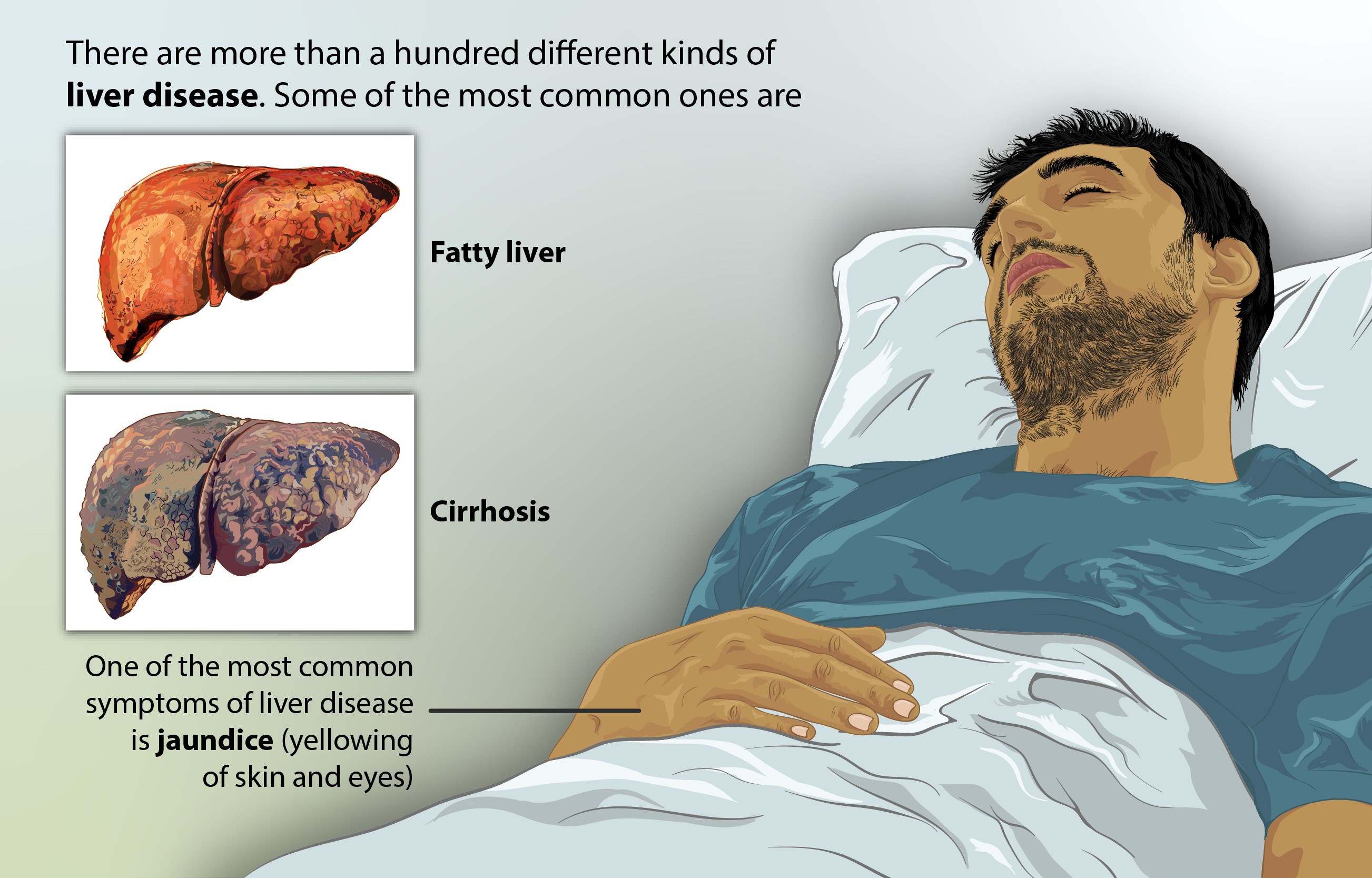
Liver Cirrhosis
Gallbladder Disorders
Silybon's influence goes beyond the liver and provides valuable support for gallbladder health.
- It helps optimize bile flow, which is crucial for preventing gallstone formation and improving digestion.
- Silymarin, with its anti-inflammatory properties, also helps reduce inflammation in the gallbladder and provides relief for different gallbladder disorders.
- Additionally, Silybon plays a role in regulating cholesterol metabolism, ensuring balance, and preventing complications related to cholesterol in the gallbladder.
Off-label uses
Silybons main focus is on maintaining liver health. It also has the potential to be used for other purposes beyond its intended use. Let's explore some unconventional yet promising ways that Silybon can be utilized in treating skin conditions like acne, psoriasis, and metabolic syndrome.
Skin conditions
Silybon's exploration into areas not typically prescribed has had an impact on various skin conditions, offering a unique approach to promoting healthy skin. It possesses qualities that protect the skin with its antioxidants, shielding against oxidative stress and environmental harm.
Silymarin also plays a role in supporting collagen synthesis, which helps improve skin elasticity and reduce the visibility of lines and wrinkles. Additionally, Silybon's anti-inflammatory properties can help alleviate redness and irritation commonly associated with skin conditions, providing a soothing effect.
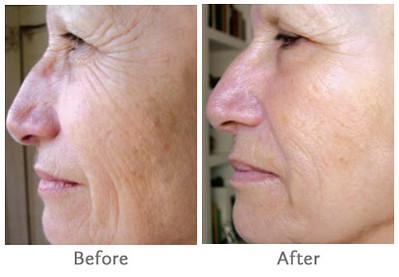
Wrinkles before and after
Acne
Silybon's exploration of addressing acne reveals a perspective on managing this common skin concern.
- It works by regulating the production of sebum preventing oiliness, which is known to contribute to the development of acne.
- Additionally, Silybon has properties that can combat bacteria responsible for causing acne, leading to decreased inflammatory acne breakouts.
- Moreover, it may also have an impact on immune responses, potentially helping to modulate the inflammatory pathways associated with acne.
Psoriasis
When it comes to psoriasis, Silybon's off-label use offers an approach to managing this persistent skin condition. One potential benefit is its ability to regulate the system, which could help control the abnormal immune activity that leads to psoriasis flare-ups.
Additionally, Silybon's properties may slow down the shedding of skin cells typically seen in psoriasis which could potentially alleviate symptoms. Moreover, its anti-inflammatory properties might provide relief from the itching and discomfort commonly associated with psoriasis.
Metabolic Syndrome
Silybon's exploration of metabolic syndrome highlights the impact it can have on various interconnected aspects of health beyond just the liver.
- One such aspect is insulin sensitivity, where silymarin influence may contribute to managing metabolic syndrome in addressing insulin resistance.
- Additionally, Silybon's ability to modulate metabolism can have an impact on cholesterol levels and triglyceride concentrations, which are important components of metabolic syndrome.
- Moreover, its anti-inflammatory properties may also play a role in reducing inflammation associated with metabolic syndrome.
Dosage and Administration
It is crucial to have a grasp of how to properly use and administer Silybon in order to achieve the best possible treatment results. The recommendations for its dosage and administration are customized to address health conditions with a particular emphasis on liver diseases and gallbladder disorders.
Recommended dosage for different conditions
The dosage of Silybon varies depending on the condition being treated. It is not a one size fits approach.
- For liver diseases, the standard dosage usually falls between 140 to 420 milligrams per day divided into doses.
- When it comes to gallbladder disorders, the dosage may need to be adjusted carefully, with recommended doses ranging from 140 to 280 milligrams per day.
Administration methods
Silybon can be administered in ways to cater to the diverse needs of patients. One common and patient-friendly method is ingestion, where Silybon is typically taken with water to ensure it is absorbed and distributed throughout the body. Another method, administration, is used when rapid and precise delivery is required. This allows for entry into the bloodstream, leading to faster therapeutic effects.
Side Effects
Although Silybon is widely recognized for its effects in medical treatment, it is vital to have a thorough knowledge of any potential adverse reactions to make well-informed decisions regarding healthcare.
Overview of potential side effects
Silybon is generally well tolerated. It's important to be aware of potential side effects that may require monitoring and medical attention. These side effects can be divided into categories;
1. Common Side Effects: These are usually mild reactions that may diminish as your body adjusts to the medication.
2. Gastrointestinal Issues: Some people may experience discomfort in the system, such as nausea, abdominal cramps, or diarrhea.
3. Allergic Reactions: Although rare, there is a possibility of reactions like skin rashes, itching, or swelling.
If you encounter any of these symptoms, seek medical attention. It's essential to stay vigilant for any signs of these side effects while taking Silybon and consult a healthcare professional if needed.
Common side effects
When it comes to the side effects there are some common things to take note of that can give us an idea of how the medication affects the body. One of these is gastrointestinal issues like feeling full, having gas, or occasionally experiencing loose stools. Another thing to watch out for is reactions, although they don't happen often. These reactions can show up as a rash or itching, on the skin. It's important to keep a close eye on any changes.
Gastrointestinal issues
Due to the impact of Silybon on the system, certain individuals might encounter gastrointestinal effects, although they are typically mild and temporary.
- Nausea, which can be sporadic, might be felt during the initial stages of treatment but tends to diminish as the body becomes accustomed to it.
- Mild abdominal cramps could also be experienced by some individuals as a result of how the medication interacts with the tract.
- Additionally, infrequent episodes of diarrhea might occur but often resolve without any intervention as the body adjusts to Silybon.
Allergic reactions
Although it is uncommon, it is important to be cautious and seek medical attention if you experience any allergic reactions to Silybon.
- These reactions can include skin rashes, which indicate a response to the medication.
- Itching, also known as pruritus, is another allergic symptom that highlights the need for prompt medical evaluation.
- In some cases, there may be swelling in the face or extremities, requiring immediate discontinuation of the medication and medical intervention.
Serious Side Effects
While Silybon provides a range of advantages, it is crucial to have a comprehensive understanding of the potential risks and adverse effects. This is especially important when considering its impact on blood sugar levels and how it might interact with medications.
Impact on blood sugar levels
The impact of Silybon on blood sugar levels is a consideration, especially for people who are managing conditions like diabetes.
- This medication can increase the risk of hypoglycemia, which means that blood sugar levels can become too low. It
- is important to monitor blood glucose levels so that healthcare professionals can make necessary adjustments to diabetes management plans.
- When prescribing Silybon to individuals with diabetes, it is crucial to take a personalized approach in order to prevent any complications.
Interactions with medications
It's important to pay attention to how Silybon can interact with medications in order to avoid any negative effects and ensure that the treatment outcomes are optimized. Here are some points to consider;
1. Anticoagulants; When taking Silybon alongside medications, it's necessary to monitor the situation carefully so as not to disrupt the blood clotting process.
2. Antiplatelet Drugs: Combining Silybon with drugs requires caution as this interaction may affect platelet function and the body's ability to stop bleeding.
3. Drug Metabolism: Silybon can influence the way certain medications are processed by the liver enzymes, which means that dosage adjustments may be needed for those medications in order to maintain their effectiveness and safety.
Overall it's crucial to be aware of these interactions between Silybon and other medications in order to ensure a safe and effective treatment plan.
Interactions
Silybon interactions go beyond the usual drug interactions. They also include pharmaceuticals and herbal supplements, which means it's important to have an understanding to provide holistic patient care.
Drug interactions with Silybon
The complex interplay between Silybon and other medications requires attention to ensure a harmonious balance.
- When it comes to drugs, Silybon has the potential to affect blood pressure, so it's important to closely monitor and prevent any hypotensive effects.
- When using immunosuppressants alongside Silybon, it's crucial to strike a balance between reaping the benefits and considering potential immune modulation.
- Additionally, since Silybon can impact liver enzymes, adjustments may be necessary for statin medications to maintain their effectiveness in lowering lipid levels.
Pharmaceuticals
Silybons' relationship with pharmaceuticals is complex as it interact with medications, affecting their effectiveness and how they are processed in the body.
- When taking medications, it may be necessary to make adjustments to the dosage of both Silybon and the antifungal agent to ensure that they work properly.
- For individuals who take diabetic drugs, it is important to coordinate closely with these medications to avoid low or high blood sugar levels.
- When using drugs, careful management is needed to optimize their effectiveness and minimize potential side effects.
Herbal supplements
The interaction between Silybon and herbal supplements adds a layer of complexity. It's important to note that certain herbs can either enhance or reduce the effects of Silybon.
- For example, if you're taking St. John Wort, a supplement, it might affect how Silybon is metabolized and, therefore, impact its therapeutic benefits.
- However, it may seem like a match at first glance; combining high doses of milk thistle supplements with Silybon requires caution due to potential additive effects.
- When using ginseng in combination with Silybon, it's crucial to monitor your blood sugar levels as this combination could potentially affect them and overall therapeutic outcomes.
Please be aware that these interactions should be approached with care and discussed with a healthcare professional if you have any concerns or questions.
Warning
Silybon holds potential but must be used with caution to ensure safety and effectiveness. It is important to have an understanding of general precautions, considerations for allergies, and the need to monitor liver function.
General warnings for Silybon usage
Before starting Silybon therapy, it's important to follow some guidelines to reduce any possible risks and maximize the therapeutic benefits. Here are a few things to keep in mind;
1. Pregnancy and Lactation: We have limited data on the safety of Silybon during pregnancy and breastfeeding. It's crucial to approach its usage with caution. It's important to consider the potential risks involved.
2. Pediatric Population: We still have limited information regarding the safety and effectiveness of Silybon among children. Therefore it is advisable to be cautious when considering its use in this population.
3. Renal Impairment: If you have an impairment, it's important to exercise caution when using Silybon as it may affect how your body eliminates the medication, which could potentially impact its effectiveness.
Remember, it's always best to consult with a healthcare professional for advice before initiating any treatment.
Allergic reactions
Although it is uncommon, it is important to remain vigilant and seek medical attention in the event of allergic reactions to Silybon. If an individual has a hypersensitivity to Silybon or similar compounds, they may experience allergic reactions, which should prompt them to discontinue use and seek medical intervention promptly. In particular, any skin reactions such as rash, itching, or swelling should be carefully monitored as they could indicate a response.
Monitoring liver function
Given the role of Silybon in the liver, it is essential to closely monitor liver function to ensure its therapeutic benefits while managing any potential risks. Here's how we can do it;
1. Baseline Assessment: Before starting Silybon treatment, it is important to establish the liver function parameters. This will serve as a reference point for monitoring.
2. Regular Checkups: Periodic liver function tests should be conducted to detect any abnormalities that may arise during the course of treatment. These tests will help guide dosage adjustments or even discontinuation if necessary.
3. Watch for Jaundice: It is crucial to keep an eye out for any signs of jaundice, such as yellowing of the skin or eyes. If these symptoms occur, they could indicate possible liver damage, and immediate medical attention should be sought.
By following these monitoring guidelines we can ensure that Silybons benefits are maximized while minimizing risks to the liver.
Contraindication
Although Silybon is often helpful in situations it is important to know when it should not be used to ensure safety and effectiveness. It is crucial to consider allergies to Silymarin and certain medical conditions as contraindications for the use of Silybon.
Allergies to Silymarin
If you have a history of allergies to Silymarin, the ingredient in Silybon, it is recommended that you avoid using it. Allergic reactions may present as follows;
- Skin Reactions: You may experience skin rashes, itching, or swelling, which can indicate a response.
- Respiratory Issues: In rare cases, there might be respiratory symptoms such as difficulty breathing or bronchospasm.
- Anaphylaxis: In situations anaphylaxis can occur, and immediate medical attention would be necessary.
Specific Medical Conditions
Certain medical conditions may require caution or avoidance when using Silybon due to interactions or worsening of underlying health problems.
1. Severe Liver Impairment: If someone has liver disease and their liver function is severely compromised it may not be advisable to use Silybon because its breakdown in the body depends on liver processes.
2. Bleeding Disorders: Individuals with active bleeding disorders should be careful or avoid using Silybon due to potential interactions with blood clotting mechanisms.
3. Organ Transplantation: After undergoing an organ transplant, especially involving the liver, Silybon might interfere with medications. This requires consideration and medical supervision.
Handling Precautions
To ensure that Silybon remains effective, it is important to handle it. This includes taking into account factors such as storage conditions, temperature sensitivity, light exposure, and shelf life. By following these precautions, you can maintain the integrity and effectiveness of the medication.
Storage recommendations
It is crucial to store Silybon in order to maintain its effectiveness and stability. Make sure to keep it in a dry place to avoid any degradation caused by moisture. Also, shield it from sunlight as exposure to UV rays can potentially affect its composition. Lastly, remember to store the medication out of reach of children to prevent any ingestion.
Temperature and light sensitivity
To ensure the effectiveness of Silybon, it is important to take precautions regarding temperature and light;
1. Avoid Extreme Temperatures; Keep Silybon from extremely hot or cold conditions as they can potentially affect its stability.
2. Protect from Light: Store Silybon in packaging or containers that are resistant to light in order to minimize exposure and preserve its therapeutic properties.
By following these measures, you can maintain the quality and efficacy of Silybon.
Shelf life considerations
It's important to understand how long Silybon can be used effectively to ensure that you get the therapeutic benefits. Here are a few steps you can follow;
1. Check Expiry Dates: Make sure you regularly check the expiration date of your Silybon medication and avoid using it if it has expired. Expired medication may not be as effective. Could pose potential health risks.
2. Dispose of Expired Medication: Safely get rid of any expired Silybon medication to prevent accidentally using it and risking your health. Proper disposal is crucial to maintain safety.
3. Follow Manufacturer Guidelines: Always follow the storage conditions and shelf life recommendations provided by the manufacturer for results with your Silybon medication.
By following these guidelines, you can ensure the usage of Silybon and maximize its therapeutic benefits while minimizing any potential risks.
Administration to special populations
Adjusting the way Silybon is given to groups requires careful thought to meet the particular requirements of older individuals, expectant mothers, breastfeeding women, and children.
Elderly patients
When it comes to patients, it's important to take a careful and personalized approach when administering Silybon. Here are a few things to keep in mind;
1. Keep an eye on their kidney function. Since renal function can change with age, it's crucial to monitor it and adjust the dosage if necessary.
2. Consider any health conditions they may have. It's essential to evaluate and take into account any comorbidities, especially cardiovascular conditions as they could potentially interact with Silybon.
3. Customize the dosage; Make sure to tailor the dosage based on the health of the elderly patient. This helps minimize the risk of any effects.
By following these guidelines, you can ensure that elderly patients receive individualized care when using Silybon.
Pregnant women and nursing mothers
Using Silybon while nursing requires careful evaluation of the possible advantages and disadvantages. It is important to consult with healthcare professionals to consider the benefits compared to the potential risks during pregnancy and breastfeeding. Each situation should be individually assessed to determine whether using Silybon is the option. In some cases, healthcare providers may suggest exploring alternative options or discontinuing its use during pregnancy and breastfeeding.
Children
Given the qualities of children, it is crucial to exercise caution when administering Silybon to pediatric populations. Here's how to ensure usage;
1. Evaluate Risk Benefit Ratio: Assess the pros and cons of using Silybon in children, taking into account interactions and developmental factors.
2. Seek Guidance from Pediatricians; Collaborate with healthcare professionals specialized in pediatrics for informed decision-making and optimal treatment outcomes.
3. Tailor Dosage, for Each Child; Adjust the dosage considering the childs weight, age and overall health condition to guarantee safety and effectiveness.
These measures will help ensure that Silybon is used appropriately in children while prioritizing their well-being.
Overdosage
It is important to be vigilant in preventing excessive dosage to ensure the safety of patients. Identifying symptoms, taking action, and promptly seeking medical assistance are vital elements in handling cases of Silybon overdose.
Symptoms of overdosage
Recognizing the indications of taking too much medication is crucial to intervening promptly.
- If you experience issues like nausea, vomiting, or abdominal discomfort, it could be a sign of an overdose and require medical attention.
- Likewise, if you notice any symptoms, such as confusion or dizziness, it's important to address them promptly.
- Additionally, overdosage can affect your system, potentially causing changes in heart rate or blood pressure that need immediate medical evaluation.
Emergency measures
In situations where an overdose occurs, it is essential to take action
- Seek Medical Assistance: If you notice any signs of an overdose, it is important to seek medical attention promptly. This will help evaluate the seriousness of the situation and initiate measures.
- Contact Emergency Hotline: If your area has emergency hotlines available, reach out to the relevant emergency services for guidance on how to handle an overdose of Silybon.
- Do Not Delay Treatment: Acting quickly is crucial in order to prevent potential complications that may arise from a Silybon overdose.
Contacting healthcare professionals
It is essential to maintain communication with healthcare professionals when dealing with an overdose of Silybon. Here are a few steps to follow;
1. Provide Detailed Information: Make sure to give healthcare professionals details about the amount of Silybon consumed, the time it was ingested, and any symptoms observed. This information will help them assess the situation effectively.
2. Follow Medical Advice: It's crucial to adhere to the guidance provided by healthcare professionals regarding diagnostic tests, treatment options, or supportive care measures. They have the expertise to guide you in managing the situation.
3. Regular Follow-ups: Keep up with scheduled follow-up appointments with your healthcare providers so that they can monitor your progress and make adjustments to your treatment plan if required. Remember, open and ongoing communication is key in managing an overdose situation like this.
Supportive care measures
Supportive care measures are important in the management of Silybon overdosage. In some cases, gastric lavage might be considered to remove any unabsorbed Silybon from the stomach. Administration of activated charcoal could help limit the absorption of Silybon if it was recently ingested. Symptomatic treatment involves addressing symptoms, such as providing antiemetic medications for nausea or implementing supportive measures to maintain cardiovascular stability.
Popular Products
Similar Product
Generic Chenix
150 mg, 250 mg, 300 mg

